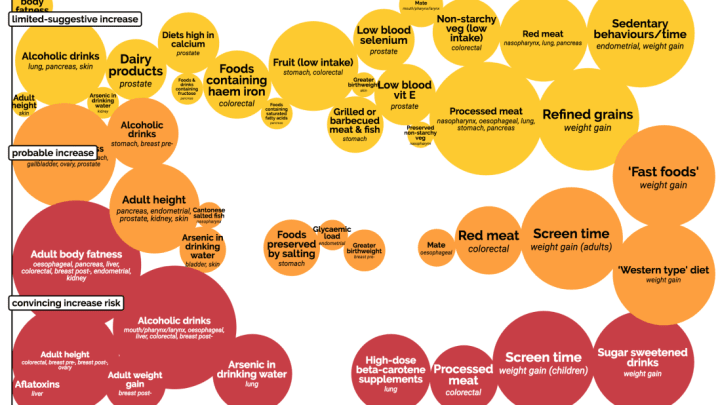If you read a lot of health news, you probably spend an inordinate amount of time worrying about your cancer risk. Will drinking too much coffee give you cancer? What about eating hot dogs? Or using a cell phone? Since it can be difficult to interpret the research, the World Cancer Research Fund has an interactive graphic, as Lifehacker spotted, that can help put things into perspective.
The World Cancer Research Fund, an international network of cancer prevention charities based in the U.S., the UK, the Netherlands, and Hong Kong, is dedicated to the science of how diet, nutrition, and physical activity affect cancer risk. Its Interactive Cancer Risk Matrix (see the full version here) visualizes what current research says about cancer risk and prevention in regards to lifestyle choices, like eating processed meat or having been breastfed as a child. (It doesn’t, however, include the genetic factors that play a role in cancer risk.) It features both factors that increase your risk for certain cancers—bacon and booze, for example—and factors that seem to decrease your risk, like eating a lot of whole grains and staying active.

The visualization divides risk factors into three categories: convincing, probably, or limited-suggested evidence. The first two mean that there’s significant research to show a causal link between those factors and either an increase or decrease in cancer risk. Limited evidence means there’s not enough definitive research for experts to be confident making a recommendation either way—the studies suggesting a link might be of poor quality, or the results too inconsistent to make a definitive call on it, even if there has been some evidence to suggest it has an effect.
These lifestyle factors don’t usually affect your risk of all cancers, so the graphic specifies which cancer each risk factor is associated with. As a result, some factors show up in multiple spots. A high adult body weight has been shown to have a probable increase in risk for cervical cancer, for instance, but a convincing increase in risk for other cancers, like liver cancer, colorectal cancer, and kidney cancer.
Not all of the risk factors are intuitive. Sure, arsenic in drinking water might increase your risk of lung cancer, but what does drinking mate have to do with cancer? Each of the bubbles is a link to the site’s in-depth webpages on related research, so if you click on the “mate” bubble, it will take you to a research digest of what current science tells us about the links between non-alcoholic drinks and cancer risk.
Explore for yourself here.
[h/t Lifehacker]
